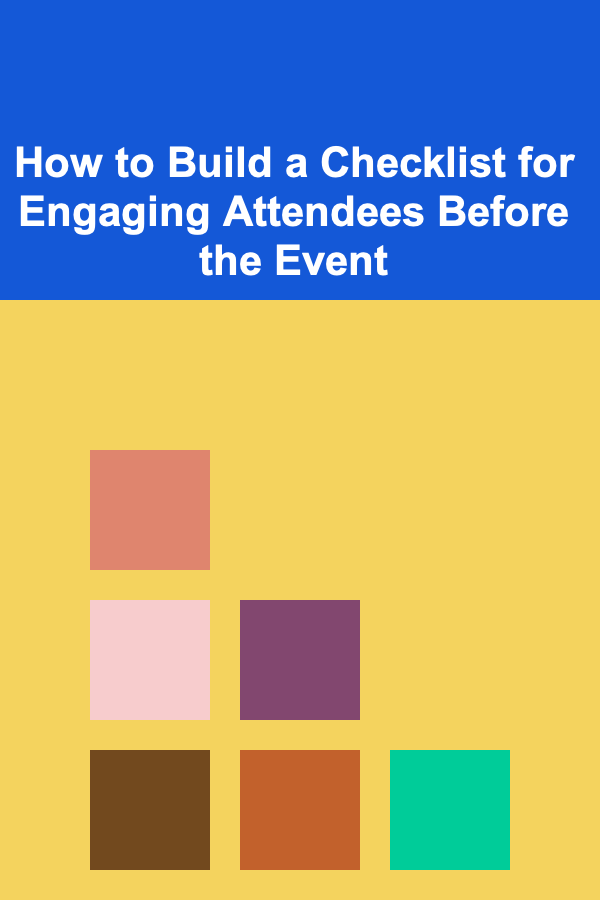
How to Build a Checklist for Engaging Attendees Before the Event
ebook include PDF & Audio bundle (Micro Guide)
$12.99$11.99
Limited Time Offer! Order within the next:

Engaging attendees before an event is a crucial aspect of creating a memorable and successful experience. Whether it's a conference, a webinar, a trade show, or a product launch, the level of engagement leading up to the event can significantly influence the turnout, the quality of participation, and the overall impact on your brand or organization. The pre-event engagement strategy sets the tone, gets attendees excited, and ensures they come prepared and eager to participate.
In this guide, we will walk you through how to build an actionable checklist that will help you effectively engage attendees before the event. From pre-event marketing to personalized outreach and community building, this checklist will ensure that your attendees are not just passive participants but active contributors to the success of your event.
1. Define Your Objectives for Pre-Event Engagement
Before diving into the tactics and tools, it's essential to clarify what you aim to achieve with your pre-event engagement efforts. Knowing your goals will help you shape your approach and ensure that all actions you take are aligned with the event's overall mission.
Key Objectives Might Include:
- Increasing Attendance: The primary goal of pre-event engagement is to get people excited about the event and encourage them to register and show up.
- Building Anticipation: Creating buzz around the event to generate excitement and anticipation. This helps to ensure your audience is looking forward to the event.
- Enhancing Networking: Providing attendees with opportunities to connect with each other before the event so they can make the most of their time during the event itself.
- Educating and Preparing Attendees: Giving your audience the information they need to maximize their experience---whether it's session schedules, speaker backgrounds, or event logistics.
- Establishing Thought Leadership: Positioning the event and your brand as a key player or thought leader in your industry.
2. Segment Your Audience
A one-size-fits-all approach to pre-event engagement is unlikely to be effective. Instead, segment your audience based on various factors such as attendee type, interests, or previous interaction with your brand. Tailoring your engagement strategy to different audience segments will ensure more relevant and personalized communication.
Segmentation Ideas:
- Type of Attendee: Differentiate between VIPs, speakers, sponsors, media, and general attendees. Each group will require different types of engagement and communication.
- Interests or Track Preferences: If your event offers multiple sessions or tracks, categorize attendees based on their interests or chosen topics.
- Engagement History: Consider how attendees have interacted with your brand before. Have they attended your events in the past? Are they active followers on social media? Do they belong to your mailing list?
3. Create Compelling, Personalized Invitations
An engaging pre-event invitation can spark interest and drive early registration. Instead of sending out a generic email blast, consider crafting personalized invitations that speak to each segment of your audience and highlight what will be most relevant to them.
Key Actions:
- Personalize the Message: Use the recipient's name, mention their past interactions (if applicable), and tailor the message to their specific needs or interests related to the event.
- Craft an Intriguing Subject Line: The subject line should grab attention and entice the recipient to open the email. It should clearly convey the value they'll get from attending the event.
- Use Visuals and Videos: Incorporate visuals like event posters, speaker photos, or short video clips that give a preview of what's to come. Video has been shown to increase engagement and response rates.
- Offer Early Bird Incentives: If applicable, offer early registration discounts, VIP access, or exclusive content for those who sign up before a certain date. This will drive early commitment.
4. Leverage Social Media for Pre-Event Buzz
Social media is a powerful tool for pre-event engagement. It allows you to reach a wide audience, create conversations, and build excitement.
Key Actions:
- Create a Unique Event Hashtag: Encourage attendees to use a unique event hashtag across social platforms. This helps create a sense of community and anticipation as people start discussing the event.
- Tease Event Content: Share sneak peeks of event content, such as speaker announcements, session topics, or behind-the-scenes footage of event preparation.
- Run Countdown Campaigns: Start a countdown to the event with daily or weekly posts, reminding attendees of key event details and generating excitement as the date draws near.
- Host Pre-Event Contests or Giveaways: Engage your audience by hosting contests or giveaways that require attendees to engage with your event's social media channels. This could involve sharing event posts, tagging others, or submitting their ideas or expectations for the event.
5. Send Pre-Event Information Packets
Well-informed attendees are more likely to engage meaningfully at your event. A pre-event information packet can help ensure that your attendees are prepared and excited for what lies ahead.
Key Actions:
- Event Schedule and Session Details: Send out the event schedule, including session times, speaker details, and topics. This helps attendees plan their time effectively and ensures they don't miss out on sessions of interest.
- Venue or Virtual Platform Information: Provide details about the event's location or how to access the virtual platform. Include maps, log-in instructions, or links to the event platform in advance.
- Pre-Event Resources: If relevant, send out any reading materials, surveys, or preparatory content that can help attendees get the most out of the event.
- Networking Opportunities: Provide attendees with details about networking opportunities, such as virtual meetups, group chats, or social events, and encourage them to engage before the event starts.
6. Engage with Attendees Through Email Campaigns
Email campaigns are an excellent way to keep your attendees informed and excited. Instead of sending just one email, consider setting up a series of emails that progressively engage your audience and provide them with value.
Key Actions:
- Event Reminders: Send email reminders leading up to the event to keep the excitement high. Remind attendees of key event details, registration deadlines, and special promotions.
- Introduce Speakers and Sessions: Highlight the event's key speakers, panelists, or session leaders in email campaigns. Share bios, interviews, or video previews to generate interest.
- Provide Interactive Content: Send out polls, quizzes, or surveys to your email list to keep them engaged and give them a chance to influence the event content (e.g., session preferences or discussion topics).
- Exclusive Content or Offers: Offer exclusive pre-event content or early access to materials such as downloadable PDFs, whitepapers, or case studies to keep your audience excited.
7. Enable Attendee Networking Ahead of Time
Creating opportunities for attendees to connect before the event can foster stronger relationships and build momentum for networking during the event itself. By setting up pre-event networking, you can encourage attendees to interact and form connections that will make their event experience more valuable.
Key Actions:
- Set Up a Networking Platform or App: Utilize event apps or online platforms that allow attendees to connect and interact before the event. Platforms like Whova or Bizzabo offer attendee networking features that make it easy for people to see who's attending and initiate conversations.
- Host Virtual Meetups or Pre-Event Webinars: Consider hosting a casual virtual meetup or webinar before the event where potential attendees can meet the speakers, ask questions, and start discussions. This is particularly effective for online or hybrid events.
- Facilitate Interest-Based Groups: If your event offers multiple tracks or topics, create groups where attendees can share their interests and connect based on these topics. It allows for more targeted networking and sets the stage for meaningful conversations at the event.
8. Incorporate Interactive Engagement Tools
Encourage engagement by incorporating interactive tools and platforms before the event. These tools help to gather feedback, engage participants, and maintain a sense of excitement.
Key Actions:
- Pre-Event Polls and Surveys: Use polls and surveys to gather information about your audience's expectations and interests. This will help you tailor content and allow attendees to feel like they're part of the planning process.
- Gamification: Add gamification elements like leaderboards, challenges, or rewards to keep attendees engaged before the event. For example, reward those who share the event on social media, refer others, or engage in pre-event content.
- Live Q&A Sessions: Host a live Q&A session with event organizers, speakers, or experts ahead of the event. This allows potential attendees to ask questions and feel more connected to the event content.
9. Monitor Engagement and Adjust Strategies
Lastly, it's essential to continuously monitor how your engagement efforts are performing and make adjustments as needed. Pay attention to the metrics and responses from your attendees to gauge the effectiveness of your efforts.
Key Actions:
- Track Open Rates and Click-Through Rates (CTR): Monitor email open rates, click-through rates, and social media engagement to see how well your messaging is resonating.
- Engage Based on Feedback: Adjust your pre-event strategies based on the feedback and insights you gather from attendees, adjusting tactics if necessary to boost engagement.
Conclusion
Engaging attendees before the event is a critical component of creating a successful and impactful experience. By building a checklist that includes segmentation, personalized communication, interactive engagement, and pre-event information, you can ensure that your attendees are excited, informed, and ready to fully participate in the event. The steps outlined in this guide will not only help you boost attendance but will also help set the stage for a more successful event overall.
Reading More From Our Other Websites
- [Trail Running Tip 101] From Beginner to Ultra: A Progressive Trail-Running Guide for Every Skill Level
- [Organization Tip 101] How to Maintain Your Craft Supply Inventory with a Checklist
- [Home Budget 101] How to Budget for Unexpected Expenses Without Stressing Your Finances
- [Home Staging 101] How to Stage Your Home for Different Buyer Demographics
- [Home Renovating 101] How to Use Exterior Home Paint Colors to Make Your House Appear Larger or More Inviting
- [Home Maintenance 101] How to Hang a TV Like a Pro Without Damaging Your Walls
- [Home Soundproofing 101] How to Soundproof Your Home Against Traffic Noise
- [Organization Tip 101] How to Organize Travel Documents for Easy Access
- [Organization Tip 101] How to Set Up a Paperless Office Environment
- [Reading Habit Tip 101] Curated Reading Lists for Busy Professionals: Quick Picks That Inspire

How to Create a Checklist for Using Props in Product Photography
Read More
How to Keep Your Oven Sparkling Clean and Functioning Well
Read More
How to Sell Used Fitness Equipment on Facebook Marketplace: An Actionable Guide
Read More
Understanding the Psychology of Influence
Read More
Navigating Economic Downturns: A Guide for Small Businesses
Read More
Mastering the Cordless Drill: Power and Versatility Unleashed
Read MoreOther Products

How to Create a Checklist for Using Props in Product Photography
Read More
How to Keep Your Oven Sparkling Clean and Functioning Well
Read More
How to Sell Used Fitness Equipment on Facebook Marketplace: An Actionable Guide
Read More
Understanding the Psychology of Influence
Read More
Navigating Economic Downturns: A Guide for Small Businesses
Read More